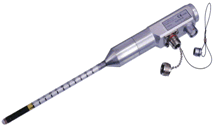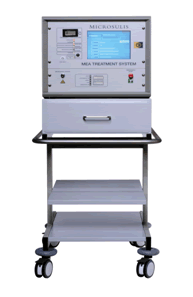


FDA
Home Page | CDRH Home Page | Search
| CDRH
A-Z Index | Contact CDRH
![]()
   |
| FDA
Home Page | CDRH Home Page | Search
| CDRH
A-Z Index | Contact CDRH
|
 |
 |
||||
 |
 |
MEA Applicator |
MEA System |
This is a brief overview of information related to FDA's approval to market this product. See the links below to the Summary of Safety and Effectiveness and product labeling for more complete information on this product, its indications for use, and the basis for FDA's approval.
Product Name: Microwave Endometrial Ablation (MEA) System
Manufacturer: Microsulis Medical Limited
Address: Microsulis House, Parklands Business Park, Denmead
Hampshire, PO7 6XP England
Approval Date: September 23, 2003
Approval Letter: http://www.fda.gov/cdrh/pdf2/p020031a.pdf
What is it? Endometrial ablation is a minimally invasive surgery that can be a viable alternative to hysterectomy. The MEA System uses microwave energy to destroy the endometrium and may minimize or even stop excessive uterine bleeding, also called menorrhagia.
The MEA System is a surgical device that uses microwave energy to treat excessive menstrual bleeding by destroying tissue lining the uterus (womb). A long slender tube that delivers microwave energy is inserted into the uterus to destroy tissue. Treatment typically lasts 3 ½ minutes and should be painless.
How does it work? After the patient receives appropriate anesthesia, the applicator is inserted through the vagina into the uterus. A computer is used to deliver microwave energy which causes a rise in temperature where the tip of the applicator meets the tissue. The surgeon moves the applicator in a sweeping motion from side to side across the tissue while slowly pulling the applicator out of the uterus. This “painting” of the inside of the uterus with the applicator destroys the endometrium. The endometrium is a fluffy layer of tissue lining the uterus that passes out of the body with the blood when women menstruate (monthly period).
When is it used? This device is intended for pre-menopausal (pre-change-of-life) women whose child-bearing is completed and who have a condition called menorrhagia, in which there is excessive uterine bleeding. The device is used only in women whose menorrhagia is due to non-cancerous causes.
What will it accomplish? The MEA System was shown to successfully reduce menstrual bleeding to normal levels one year after treatment in approximately 87% of women in a clinical study. In approximately 55% of women, menstrual bleeding was totally stopped.
The most common side effects of this treatment include:
When should it not be used? This device should not be used in a patient who:
Microwave Endometrial Ablation is not a sterilization procedure.
Reducing Patient Risk
FDA has reviewed 27 reports of rare serious injuries that occurred in MEA procedures performed outside the U.S. In these cases, patients experienced burns through their uterus and intestines that required abdominal surgery to remove damaged tissue and repair the intestines.
To reduce the risk of injury, surgeons performing MEA procedures must now:
These procedures were introduced during the U.S. clinical trial, and no injury of this type was observed. However, the number of patients in the clinical trial who underwent the MEA procedure was not large enough to conclude that these additional requirements eliminate the risk of injury.
Additional information: Summary of Safety and Effectiveness and labeling will be available at: http://www.fda.gov/cdrh/pdf2/p020031.html
Other:
January 21, 2004
![]()
CDRH Home Page | CDRH A-Z Index | Contact CDRH | Accessibility | Disclaimer
FDA Home Page | Search FDA Site | FDA A-Z Index | Contact FDA | HHS Home Page
Center for Devices and Radiological Health / CDRH